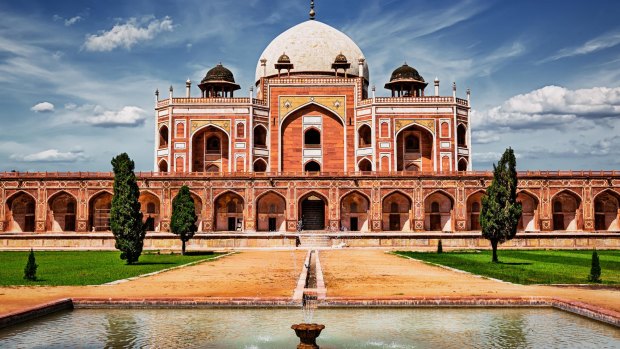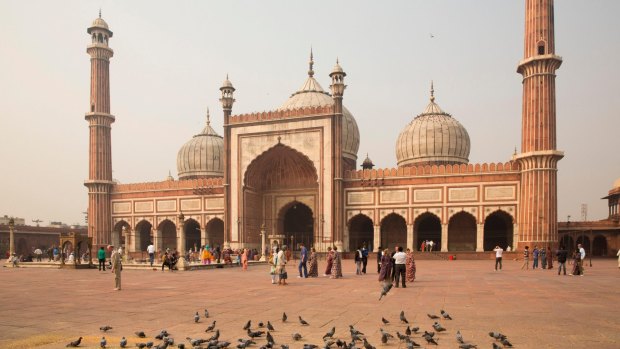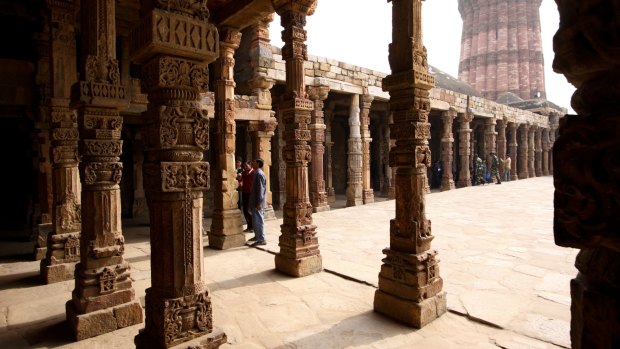
Humayun's Tomb, Delhi.Credit: Alamy
HUMAYUN'S TOMB
This massive mausoleum of one of the great Moghul emperors (and his royal relatives) was built in the 16th century and, with its innovative Persian-inspired design, foreshadows the Taj Mahal in its elegant, domed symmetry. It's astounding that it isn't better known. The building of purple-red sandstone atop a double-tiered stone platform is massive yet appears delicate thanks to arches, latticed windows and elegantly inlaid marble. Surrounding gardens are divided into squares by trickling water channels, and entirely enclosed in walls. Gateways frame marvellous views of the mausoleum. Further tombs and crumbling memorials lie in sprawling gardens beyond.
JANTAR MANTAR
This 18th-century observatory consists of giant marble and sandstone astronomical instruments standing like contemporary sculptures among well-kept flowerbeds and palm trees. Each instrument is variously able to locate the pole star, the position of planets or the declension of stars. One of the walls has a slit through which the sun shines only on March 21 and September 21. The main sundial is particularly impressive for its ability to tell local time to within 20 seconds of accuracy. It's one of the capitals most overlooked but most intriguing historical sites, often only frequented by scampering chipmunks and canoodling couples.
FRIDAY MOSQUE

Credit: Alamy
Jama Masjid was completed in 1656 by Moghul emperor Shah Jehan. The imperial showpiece of red sandstone is anchored by minarets striped with white marble like giant candy canes, and topped by black-and-white striped domes. Its Persian-inspired vaults and domes are very Islamic, its roof beams and brackets distinctively Hindu. Bearded men recline on patterned Kashmir carpets under the colonnades of its vast courtyard, from which there are outlooks over the old town or towards the Red Fort. Marble floors imitate the ornamentation on Islamic prayer mats, and a small pavilion houses relics of the Prophet Mohammed.
RED FORT
This vast statement of Moghul might, more entire mini-city than fort or palace, has massive red walls topped by dainty red and pink pavilions. Most of the labyrinthine complex's 17th-century buildings (plus a few British-era additions) are empty, but provide an atmosphere of melancholy magnificence. One pavilion, embellished with amber and jade, is inscribed with a verse by Shah Jehan's prime minister: "If there be paradise on the face of earth, it is this!" In the late afternoon, when sun turns sandstone to crimson as the light fades over this palace of lost dreams, it's hard to disagree.
QUTAB MINAR

Credit: Alamy
India's largest stone tower is a massive fluted column scribbled with Koranic inscriptions and dotted with balconies like swallow's nests. It was built in the late 12th century and looms over the ruins of India's first mosque, which has some surprising Hindu motifs, since materials were used from a Hindu temple that once stood on the site. The tower is impressive enough, but surrounds acres of other ruined mosques, buildings and ornamental arches, many elaborately decorated with both Hindu brackets and Arabic calligraphy. Green parrots flutter against crumbling red walls, and local visitors in bright saris chatter.
RAJ GHAT
This landscaped ghat on the banks of the Yamuna River was the site of Mahatma Gandhi's cremation on January 30, 1948, the day following the independence leader's assassination. A simple black marble slab is surrounded on four sides by walls that you can walk like ramparts. The slab is engraved with Gandhi's final words, "Hai Ram (Oh God)", and the walls inscribed with his sayings. A steady stream of local visitors pays their respects. Though less frequented, other monuments along this site remember various Indian leaders including Nehru, Narayanan, and Indira Gandhi and her son Rajiv, both also assassinated.
Brian Johnston was a guest of Luxury Gold and Malaysia Airlines.
Sign up for the Traveller Deals newsletter
Get exclusive travel deals delivered straight to your inbox. Sign up now.